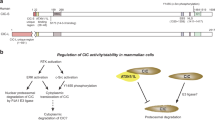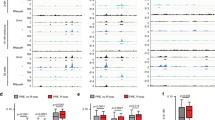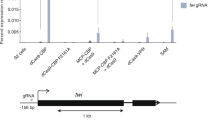Abstract
Human CCAAT displacement protein (CDP), a putative repressor of developmentally regulated gene expression, was purified from HeLa cells by DNA binding-site affinity chromatography. cDNA encoding CDP was obtained by immunoscreening a λgt11 library with antibody raised against purified protein. The deduced primary amino acid sequence of CDP reveals remarkable homology to Drosophila cut with respect to the presence of a unique homeodomain and “cut repeats”. As cut participates in determination of cell fate in several tissues in Drosophila, the similarity predicts a broad role for CDP in mammalian development.
This is a preview of subscription content, access via your institution
Access options
Subscribe to this journal
Receive 12 print issues and online access
$209.00 per year
only $17.42 per issue
Buy this article
- Purchase on Springer Link
- Instant access to full article PDF
Prices may be subject to local taxes which are calculated during checkout
Similar content being viewed by others
References
Royer-Pokora, B. et al. Nature. 322, 32–38 (1986).
Skalnik, D.G., Strauss, E.C. & Orkin, S.H. J. biol. Chem. 266, 16736–16744 (1991).
Barberis, A., Superti-Furga, G. & Busslinger, M. Cell 50, 347–359 (1987).
Superti-Furga, G. et al. Biochim. Biophys. Acta. 1007, 237–242 (1989).
Blochlinger, K. et al. Nature. 333, 629–635 (1988).
McGinnis, W. & Krumlauf, R. Cell 68, 283–302 (1992).
Bodmer, R. et al. Cell 51, 293–307 (1987).
Liu, S., McLeod, E. & Jack, J. Genetics 127, 151–159 (1991).
Laemmli, U.K. Nature 227, 680–685 (1970).
Ginsburg, D. et al. Science 228, 1401–1406 (1985).
Kozak, M. Cell 44, 283–292 (1986).
Scott, M.P., Tamkun, J.W. & Hartzell, G.W.I.I.I. Biochim. biophys. Acta. 989, 25–48 (1989).
Treisman, J. et al. Cell 59, 553–562 (1989).
Hanes, S.D. & Brent, R. Cell 57, 1275–1283 (1989).
Otting, G. et al. EMBO J. 9, 3085–3092 (1990).
Laughon, A. Biochemistry 30, 11357–11366 (1991).
Sweet, R.W., Chao, M.V. & Axel, R. Cell 31, 347–353 (1982).
Rosenfeld, M.G., Dev. 5, 897–907 (1991).
Frigerio, G. et al. Cell 47, 735–746 (1986).
Fortini, M.E., Lai, Z.C. & Rubin, G.M. Mech. Dev. 34, 113–122 (1991).
Karisson, O. et al. Nature. 344, 879–882 (1990).
Jan, Y.N. & Jan, L.Y. Trends Neurosci. 13, 493–498 (1990).
Jack, J.W. Cell 42, 869–876 (1985).
Blochlinger, K., Jan, L.Y. & Jan, Y.N., Dev. 5, 1124–1135 (1991).
Levine, M. & Manley, J.L. Cell 59, 405–408 (1989).
Lubbert, M., Herrmann, F. & Koeffler, H.P. Blood 77, 909–924 (1991).
Skalnik, D.G. et al. Proc. natn. Acad. Sci. U.S.A. 88, 8505–8509 (1991).
Selden, R.F., in Current Protocols in Molecular Biology (eds Ausubel, F. M., Brent, R., Kingston, R. E., Moore, D. D., Seidman, J. G., Smith, J. A. & Struhl, K.) 9.2.1–9.2.6 (Greene/Wiley, New York, NY, 1989).
Molecular cloning: a laboratory manual, 2nd ed. (Sambrook, J., Fritsch, E. F. & Maniatis,T.) (Cold Spring Harbor, Cold Spring Harbor, New York, 1989).
Dignam, J.D., Lebovitz, R.M. & Roeder, R.G. Nucl. Acids Res. 11, 1475–1489 (1983).
Kadonaga, J.T. & Tjian, R. Proc. natn. Acad. Sci. U.S.A. 83, 5889–5893 (1986).
St. John, T.P., in Current protocols in molecular biology (eds Ausubel, F. M., Brent, R., Kingston, R. E., Moore, D. D., Seidman, J. G., Smith, J. A. & Struhl, K.) 6.7.1–6.7.6 (Greene/Wiley, New York, 1990).
Henikoff, S., Gene. 28, 351–359 (1984).
Altschul, S.F. et al. J. molec. Biol. 215, 403–410 (1990).
Devereux, J., Haeberli, P. & Smithies, O. Nucl. Acids Res. 12, 387–395 (1984).
Bonthron, D.T. et al. Nature. 324, 270–273 (1986).
Andrews, N.C. & Faller, D.V. Nucl. Acids Res. 19, 2499 (1991).
Author information
Authors and Affiliations
Rights and permissions
About this article
Cite this article
Neufeld, E., Skalnik, D., Lievens, PJ. et al. Human CCAAT displacement protein is homologous to the Drosophila homeoprotein, cut. Nat Genet 1, 50–55 (1992). https://doi.org/10.1038/ng0492-50
Received:
Accepted:
Issue Date:
DOI: https://doi.org/10.1038/ng0492-50
This article is cited by
-
A recurrent de novo CUX2 missense variant associated with intellectual disability, seizures, and autism spectrum disorder
European Journal of Human Genetics (2018)
-
Transcriptomic data from panarthropods shed new light on the evolution of insulator binding proteins in insects
BMC Genomics (2016)
-
CUX1, a haploinsufficient tumour suppressor gene overexpressed in advanced cancers
Nature Reviews Cancer (2014)
-
Inactivating CUX1 mutations promote tumorigenesis
Nature Genetics (2014)
-
Possible association of CUX1 gene polymorphisms with antidepressant response in major depressive disorder
The Pharmacogenomics Journal (2013)



